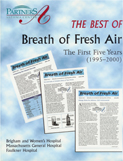Breath of Fresh Air: Feature Articles
Chapter 7: Developing your Asthma "Action Plan"
|
This summer our Asthma Center is introducing written asthma "Action Plan" cards for its patients with asthma. Our first goal in treating your asthma is prevention of asthma attacks. However, recognizing that asthma attacks will occur even with the best of medical care, we are expanding our efforts to help our patients recognize evidence of an attack of asthma and respond appropriately when one occurs. For most people with asthma, on most days breathing feels normal. Nonetheless, asthma remains present even when one feels well. Asthma is a disease or condition of the air passageways of the lungs (the bronchial tubes) that makes it possible at any time for a person with asthma to develop narrowing of the breathing tubes and, as a result, difficulty breathing. If difficulty breathing comes on relatively quickly, it often is called an "attack" of asthma. Some attacks of asthma may come on over a period of several minutes to an hour. Other attacks may develop more slowly, perhaps over several days. Some attacks are mild, and go away quickly when you use your bronchodilator medications. Other attacks are severe and may require intensive treatment with medications, sometimes even at the hospital. Good asthma care makes attacks of asthma infrequent. You may go for many months or even years without experiencing one. Still, it is important that you be able to recognize when you are having an attack and that you know how to respond wisely if one occurs. |
Having asthma puts one at risk for episodes of narrowed breathing tubes and difficulty breathing: asthma attacks. |
|
|
One way to know that you are having an attack of asthma is to be aware of the typical symptoms: these may include difficulty breathing, a heaviness in the chest, uncontrollable coughing, and wheezing or "rattling" in the chest with breathing. Another way to recognize an attack of asthma is to measure how fast you can expel air from your lungs. When the bronchial tubes narrow in an asthma attack, the speed with which you can force air from your lungs decreases significantly. A common measurement of the speed of exhalation is the "peak flow," and an accompanying article in this edition of Breath of Fresh Air [the previous chapter in this book] discusses peak flow monitoring in asthma. There are several advantages to using measurements of peak flow when assessing an asthma attack. First, sometimes the symptoms of an attack may be difficult to distinguish from other causes, for instance a head cold or "allergies." A low value for the peak flow confirms that the problem is asthma. Second, sometimes the peak flow number will decline before symptoms of asthma develop. The falling peak flow value can be an early warning sign of an asthma attack. Third, and perhaps most importantly, the peak flow value lets you know how severe the attack is. It gives you a precise measurement that can be compared with your usual value to let you know how far from normal your breathing capacity is during an attack. What actions you should take during an asthma attack will depend on how severe the attack is. |
With a peak flow meter you can measure how serious an asthma attack is. |
|
|
Besides recognizing that an asthma attack has developed, you need to have an idea about what you will do to get better again; you need a plan. We encourage you to discuss with your physician what steps he or she would recommend for you to follow in the event of an asthma attack. Sometimes, this plan will include increasing the frequency or number of puffs of your inhalers. Sometimes, it may include taking corticosteroids by mouth (for example, prednisone). Sometimes, it may involve a telephone call or visit to the Asthma Center; and sometimes it may require calling an ambulance to take you to the nearest Emergency Department of a hospital. We feel that having a written asthma "Action Plan" will help you to remember the specific details of your conversation with your doctor about what to do during an asthma attack. A wallet-sized "Action Plan" card is available for you at your next visit to the Asthma Center. Mention it to your doctor, who will fill one out with you, and keep it some place handy. We hope that you will rarely, if ever, need it. |
Have a plan of what you will do if you have an asthma attack: an “action plan.” |

